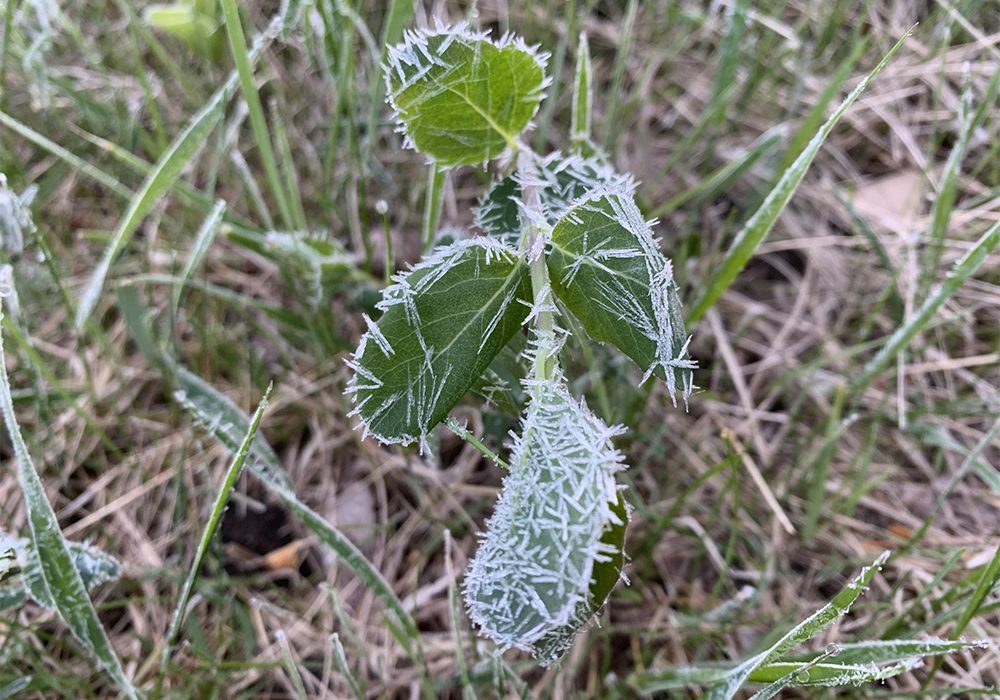Hard frost in Manitoba may force reseeding

A killing frost arrived this morning in parts of Manitoba, with temperatures dipping to minus four in certain locations.
One of those locations was Roberta Galbraith’s farm near Minnedosa.
“It was minus 3 this morning at the house and down in the valley, in spots, it was minus 4,” said Galbraith, who operates a grain farm, growing canola, soybeans and other crops. “We think it lasted maybe three hours, maybe four.”
Weather data from Manitoba Agriculture shows that temperatures dipped below –3 C at multiple sites in the province. Many of the colder temperaturess were recorded in the northwest region (north of the Yellowhead Highway) and in the Interlake:
· Neepawa: – 4 C for about three hours
· Arborg: colder than – 4 C for four hours
· Russell: – 2 C for about two hours
· Grandview: – 4 C for two hours
· Ste Rose: dropped to -4 C for about three hours
In regions south of the Trans-Canada and into eastern Manitoba, air temperatures did drop below freezing, but the frost was less severe:
· Holland: around -1 C for four hours
· Morris: dipped below zero for only an hour
· Boissevain: just below zero for two hours
· Ste. Claude: -1 C for three hours
However, there were areas in the eastern half of Manitoba that did get a harder frost, like Beausejour, which dropped to – 2 C for about three hours.
A substantial amount of soybeans are grown around Beausejour, northeast of Winnipeg, and farmers may be forced to re-seed those crops.
Across the province, about 30 to 40 percent of the soybean crop had emerged from the soil as of May 25, said Cassandra Tkachuk, production adviser with Manitoba Pulse & Soybean Growers. This year, Manitoba farmers will seed one to 1.3 million acres of soybeans.
The soybeans on Galbraith’s farm haven’t emerged from the soil, but canola plants on four fields have popped out of the ground.
Galbraith and her husband, Neil, will keep a close eye on those fields, but they aren’t planning to re-seed just yet.
“We’re going to wait for a few days and just monitor it,” she said.
In areas that dropped to -4 C for several hours, many canola growers will be forced to re-seed.
However, a repeat of 2015 is unlikely. On May 30 that year, temperatures sank to -4 to -7 C for a period of four or five hours. The severe frost smoked seedlings in most of southern Manitoba, and farmers had to re-seed nearly a million acres of canola.
That probably won’t happen this year because less canola has emerged from the soil. Many farmers in western Manitoba halted seeding in the middle of May because the topsoil was extremely dry.
Rain finally arrived over the May long weekend, but the delay in canola seeding should lessen frost damage because part of the province’s canola crop hasn’t been seeded or hasn’t poked out of the ground.
It’s possible that wet soils, thanks to 50 to 75 millimetres of rain over the long weekend, protected canola and soybean seedlings from the frost. Wet soils store more heat than dry soil.
Young plants can also “harden” when subjected to cool temperatures prior to a frost.
Temperatures in Manitoba were cool during part of the long weekend and near zero Tuesday night. The chilly weather may have toughened up the canola and soybean plants prior to the frost.
The damage this spring will vary from field to field in Manitoba, depending on crop emergence and the severity of the frost. As a result, growers should carefully check their fields before re-seeding, said Dane Froese, oilseed specialist with Manitoba Agriculture.
“We want to wait and see if there is any regrowth happening,” Froese said. “The damaged tissue and damaged leaves may look visually very disturbing. That doesn’t mean that crop is toast.”
In the case of canola, farmers should wait 24 to 72 hours before assessing the damage.
Ideally, they should look at plants in 20 or more locations within a field to see if the canola is recovering.
Yep that was frost last night in southern Manitoba. After rain relief farmers now left to assess the freeze damage to early crops #westcdnag pic.twitter.com/lzZsoDlqOW
— Rod Nickel (@RodNickel_Rtrs) May 27, 2021
“If we’re seeing new growth within that one, two or five days … from that main growing point on the top of the canola cotyledon, or the top of the stem,” Froese said.
For soybeans, growers should check the crop three to five days after the frost because it takes a few days for necrosis (tissue death) to set in.
“If that growing point isn’t killed off … you’ll see green material and maybe signs of re-growth,” Tkachuk said.
“You’ve got the two cotyledons on either side and the growing point is in the middle. So where you’ll see the re-growth is (at) the base of each cotyledon. That’s where you can end up with a double stem soybean plant…. And it can still produce.”
If there are enough plants with new growth or re-growth, re-seeding may not make economic sense. The re-seeded crop will have a lower yield potential because of the later seeding date. Plus, re-seeding involves fuel, time and labour costs.
To help canola growers make a thoughtful decision about re-seeding, Manitoba Agriculture has developed a re-seeding calculator (Excel file format).
A link to the calculator can be found in the province’s May 25 crop report at www.gov.mb.ca/agriculture/crops/seasonal-reports/crop-report-archive/pubs/crop-report-2021-05-25.pdf.
Contact robert.arnason@producer.com
Source: producer.com

